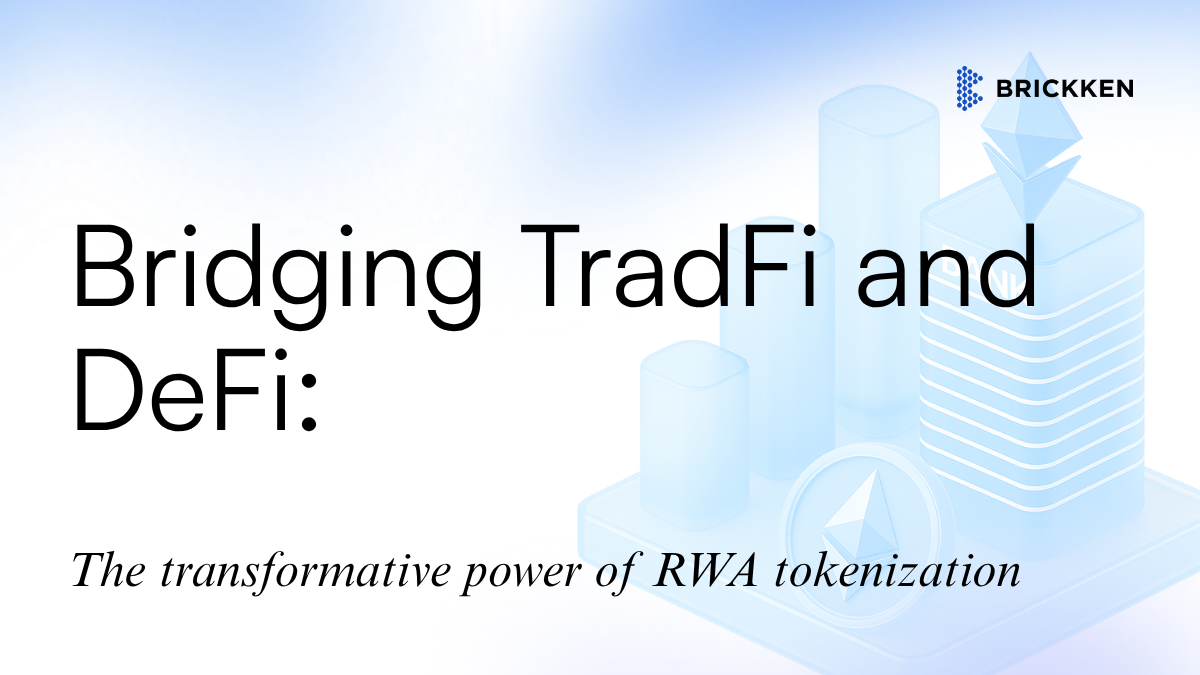Traditional finance (TradFi) and decentralized finance (DeFi) have long existed in parallel, with TradFi being grounded on its institutions and regulations - promising stability and a vast portfolio of assets for investors. Yet, it’s often slow, less transparent, and challenging for smaller investors to participate. On the flip side, DeFi thrives on innovation, speed, and global accessibility but there’s concern on security and asset diversity in contrast to TradFi.
Now we enter real world asset (RWA) tokenization, a bridge between these two sectors. By leveraging blockchain technology to transform physical assets like real estate, art, or equity into digital assets. These digital asset tokens signify fractional ownership, facilitating their investment, improving liquidity, and inviting wider market participation.
Let's dive into this pivoting space and break down its impact on both TradFi & DeFi and how businesses can tap into the full potential of tokenized digital assets.
Tokenized RWAs: a game-changer for traditional finance (TradFi)
TradFi institutions often face several challenges that digital assets can easily address:
- Liquidity constraints: Many physical assets are notoriously illiquid, making them difficult to buy or sell swiftly by enabling fractional ownership. Picture a commercial property traditionally requiring millions to invest in. Tokenization slices this property into smaller, more manageable tokens, welcoming a broader spectrum of investors and thus improving participation plus liquidity - easing market entry and exit.
- High entry barriers: Historically, investing in certain assets demands substantial capital. Consider a multi-million dollar piece of art you’d like to invest in. Fractional ownership, makes these assets accessible to a wider investor base, even those with modest investment budgets can now partake in owning high-value assets.
- Inefficiency: Traditional financial processes can be quite slow and complicated, just imagine the paperwork burden of a real estate transaction. The use of blockchain tech can optimize these transactions securely by slashing processing times, reducing errors, and administrative costs.
There are a lot of benefits that the traditional finance world can tap into through the use of digital assets on the blockchain, these are some of the main ones:
- Ensuring security: Tokenization platforms like ours guarantee a secure and compliant process that aligns with the shifting regulatory terrain around digital assets in different world regions. This instills confidence in institutions and investors alike.
- Fundraising made easier: Businesses can raise capital more efficiently by issuing asset-backed tokens. Envision a company planning to develop a new property, they can proceed to tokenize the property and offer these tokens to investors, raising funds without the complexities and restrictions of conventional methods.
- Enhancing investor access: Our Digital Asset Platform delivers an intuitive user experience for investors to engage in tokenized asset offerings, enabling institutions to tap into a global pool of investors, expanding their reach and fundraising potential.
Digital assets: propelling DeFi innovation
DeFi is known for its dynamic ecosystem of decentralized applications (dApps), however, DeFi often lacks access to the vast array of assets traditionally found in TradFi. That’s where real world asset tokenization bridges the gap by:
- Diversifying DeFi assets: By bringing real-world assets onto the blockchain, DeFi can leverage a broader range of assets for lending, borrowing, and other novel financial products - like loans backed by tokenized real estate. RWA tokenizations help DeFi platforms diversify beyond cryptocurrencies, attracting traditional investors more comfortable with tangible assets, thus increasing liquidity and adoption within DeFi.
- Enhancing collateralization: Digital assets can act as collateral for DeFi loans. This enables users to borrow funds against their holdings of tokenized assets, unlocking new lending opportunities and improving DeFi liquidity.
- Promoting transparency and security: The nature of the blockchain ensures transparent and secure transactions, which is the cornerstone for fostering trust in the DeFi ecosystem by adhering to the highest security standards, and assuring DeFi users.
- Interoperability between TradFi and DeFi: Tokenization can improve the interoperability between traditional and decentralized financial ecosystems. Real-world assets can easily integrate into decentralized protocols, allowing more efficient lending, borrowing, and fundraising across the blockchain ecosystem.
- Unlocking new DeFi use cases: Innovation in the DeFi space is fueled by providing access to a wider range of secure assets, opening doors for the development of new financial products and services that were previously unimaginable.
Challenges and considerations
Despite the many advantages, several obstacles still pose a challenge for this space:
- Regulatory uncertainty: Different jurisdictions impose varying regulations on tokenized assets, creating complexity for businesses and investors alike.
- Legal and compliance issues: Navigating the legal landscape can be tricky, particularly regarding ownership rights and securities laws.
- Technical complexities: Ensuring the scalability, security, and interoperability of blockchain platforms is crucial for the growth of tokenization.
- Market education: Many investors remain unfamiliar with tokenization, requiring more education and awareness which is an essential requirement to drive adoption and build long-term trust in the sector.
The future of finance is tokenized
The convergence of TradFi and DeFi through RWA tokenization holds tremendous promise for the future of finance. Brickken, as one of the leading projects in the space, offers a secure, compliant and easy-to-use tokenization platform, that empowers both traditional and decentralized finance players. Businesses can unlock new fundraising avenues, improve investor access, and participate in the growing DeFi ecosystem. As digital assets continue to evolve, we expect to see further innovations in the financial landscape driving further transformation of TradFi, DeFi, and the way we interact with assets.
Conclusion
RWA tokenization is reshaping both traditional and decentralized finance landscapes. With its ability to enhance liquidity, enable fractional ownership, and improve transparency - opening new avenues for businesses and investors driving the next wave of financial transformation.
